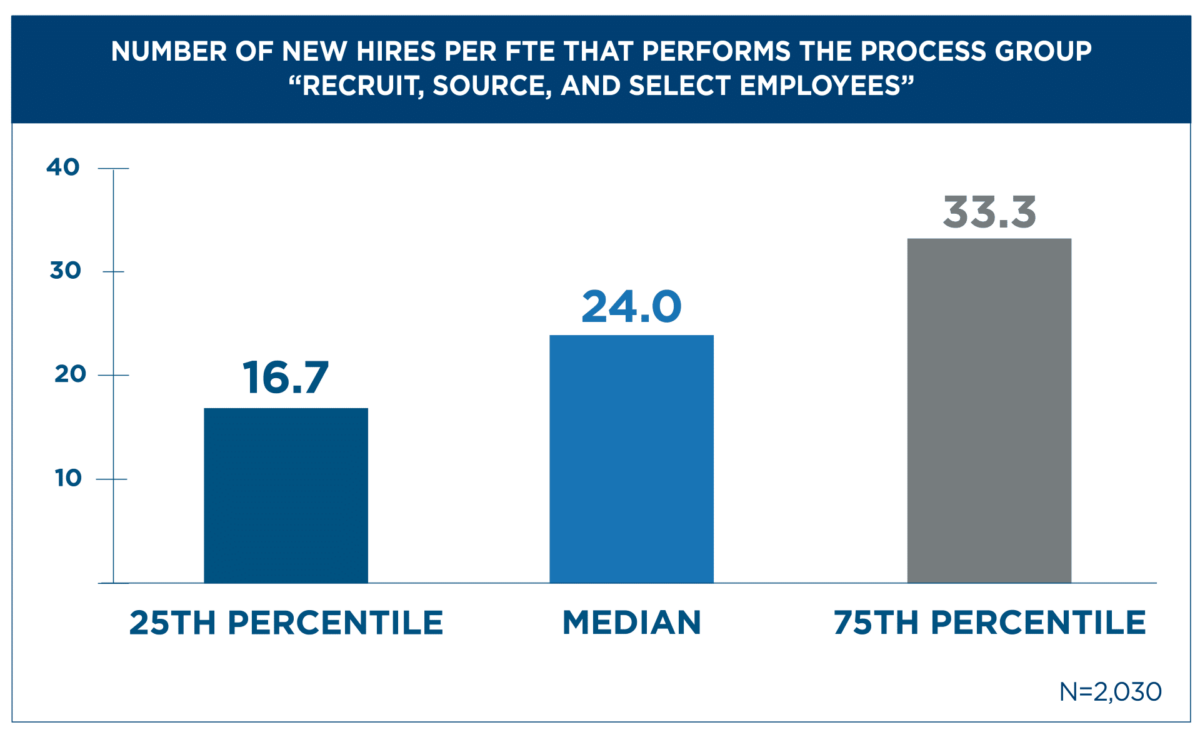Artificial intelligence (AI) is transforming the recruiting process from end to end, changing how organizations carry out key activities like sourcing, attraction, selection and more. After reviewing common use cases for AI in recruiting, we consider the potential impact of AI on recruiter workload and highlight the role that HR leaders play in determining what recruiting looks like in the age of AI.
AI is poised to reshape what recruiting looks like and is already bringing changes to many organizations. For example:
- Generative AI can give recruiters a running start by suggesting text for job descriptions or other documents.
- AI-driven tools like chatbots can answer common applicant questions. This frees up recruiters for more strategic work while allowing them to remain responsive to potential applicants.
- Screening software powered by AI can analyze resumes and CVs for specific keywords to weed out applicants who don’t meet employer criteria.
- Generative AI can create unique assessments based on a specific role or seniority level (e.g., a complex coding challenge for an advanced technical role).
- Candidates can be interviewed by chatbots, and embedded AI can analyze responses and behavior, providing additional insights to help recruiters and hiring managers make more informed decisions.
- AI can analyze large datasets to identify trends and make predictions about candidates who are most likely to perform well in a role and stay with the organization.
A common theme among these use cases for AI in recruiting is the reduction or removal of certain work from human recruiters.
Where things stand today
The number of new hires per recruiter is a key piece of information for understanding recruiter workload because it speaks directly to productivity. This measure can help you set the baseline for a realistic recruiter workload and also monitor the impact of AI on workload over time.
At the median, we find that organizations have 24 new hires per recruiter. Organizations at the 75th percentile have 33.3 (or more), while those at the 25th percentile have 16.7 (or fewer) new hires per recruiter.
At first glance, it might seem like organizations at the 75th percentile are the “top performers” with the most productive recruiters, while those at the 25th percentile are lagging. The reality, however, is more complex.
While most organizations want productive recruiters, it’s critical to ensure that productivity does not come at the expense of other recruiting goals. For example, rushing the process might result in a greater number of hires but could also lead to a lower quality experience for candidates and more stress for recruiters. To avoid these types of scenarios, it’s important to track this measure in a broader context that includes measures like:
- Cost per hire (all of the costs related to recruiting, divided by the number of hires over 12 months)
- Time to hire (i.e., the number of calendar days from approved requisition to job offer acceptance)
- Quality of hire measures like time to productivity, new hire retention, new hire performance ratings, and hiring manager satisfaction with new hires
- Employee experience measures like candidate, new hire, and hiring manager satisfaction ratings
Many organizations will choose to optimize one or two of these measures, but it’s still important to monitor them all to ensure that this optimization doesn’t conflict with expectations or requirements in the other areas.
Factors that shape where you can go in the future
Recruiter workloads are shaped by many internal and external factors. In addition to tracking recruiter productivity, it’s important to consider these factors to develop realistic expectations about what recruiting work should look like in your organization.
External factors like labor market dynamics can play a big role in shaping what recruiting work looks like. For example, a software company that needs to hire a large number of data scientists may have fewer new hires per recruiter because these skills are in higher demand and recruiters will likely need to compete harder for each hire. By contrast, a company that needs to hire employees for basic retail work could reasonably expect recruiters to get a larger number of employees through the door.
Internal factors like your timeline for filling open positions and your budget for recruiting are important to consider as well. Within HR and your recruiting function specifically, expectations around recruiter workloads are also a product of:
- Your human capital and hiring strategy;
- Your infrastructure (or lack thereof) for internal hiring;
- The structure of your recruiting function (for example, whether recruiters are decentralized across multiple offices or working as a single shared services team);
- The maturity of your recruiting processes and the degree to which they are optimized;
- Recruiters’ skills and experience; and
- The degree to which recruiters adhere to recruiting processes.
AI and recruiter workload: a key decision
It’s easy to treat questions about AI’s impact on human workers as forgone conclusions. While it’s certainly true that AI is expected to expand recruiter capacity, HR leaders still have a lot of space to influence what kind of impact it ultimately has on recruiter workload.
At the heart of the recruiter workload question is the why for AI in recruiting—in other words, the purpose or strategy behind the use of AI for these processes. This “why” should not be left to chance, nor should it be dictated by consultants or vendors with shiny new technology. It should be proactively driven by HR leaders.
What kind of opportunity will AI be for recruiting and recruiting workloads in your org?
There are a wide range of possible answers to this question. For example, AI could be:
- A cost savings opportunity. Labor costs are among the largest recruiting expenses. If you are cost-focused, your goal might be using AI to reduce recruiter headcount.
- A process accelerator. If speed is your focus, you will aim to have AI automate tasks, make decisions and provide recommendations. This will mean more time for recruiters to devote to internal hiring.
- A quality enhancer. If quality of hire is your focus, you will want AI to free up recruiter time to develop new sources of talent, build talent pipelines and develop relationships with candidates.
- An experience maker. If candidate satisfaction is your goal, your aim should be using AI to automate and personalize candidate communication, answer candidate questions and schedule interviews. This frees up time for recruiters to nurture relationships and increase human touchpoints with candidates in ways that only humans can do.
Whether you need AI to play one of these roles or something else, exploring the “why” behind AI is an important first step toward understanding how recruiters should leverage AI-driven technologies.
AI presents many opportunities for change, and business leaders hold the levers for determining what that change looks like for organizations and employees. This means that HR leaders still have a lot of space to influence what kind of opportunity AI will present when it comes to recruiting. Tracking the number of new hires per recruiter alongside measures like cost per hire and new hire quality will help you keep your goals and priorities in mind as you monitor AI’s impact on recruiting.
As recruiting tasks and decisions are automated, should your recruiters worry about AI coming for their jobs or welcome it as an opportunity to do more strategic work like relationship-building? While some HR leaders will still leave these questions to chance, those who are proactive can guide how AI impacts human recruiters, their workloads and the resulting outcomes.
Data in this content was accurate at the time of publication. For the most current data, visit www.apqc.org.
Credit: Source link











